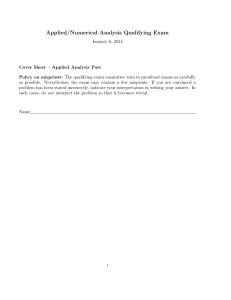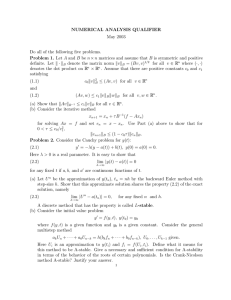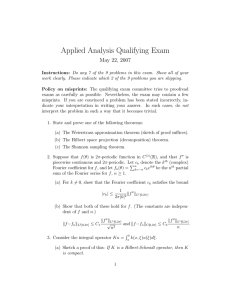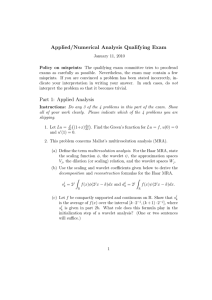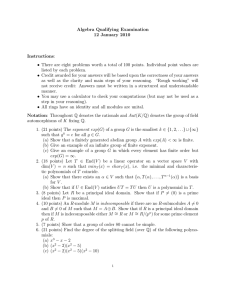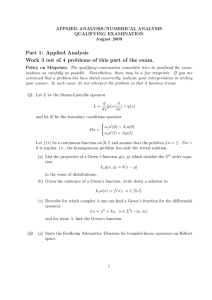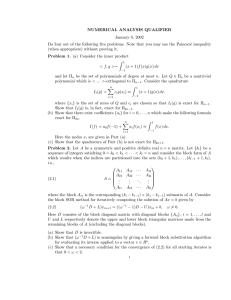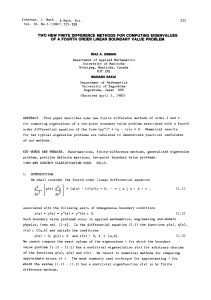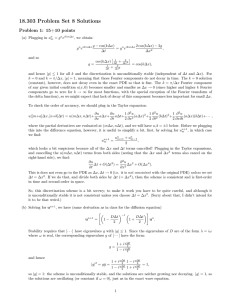Applied/Numerical Analysis Qualifying Exam
advertisement
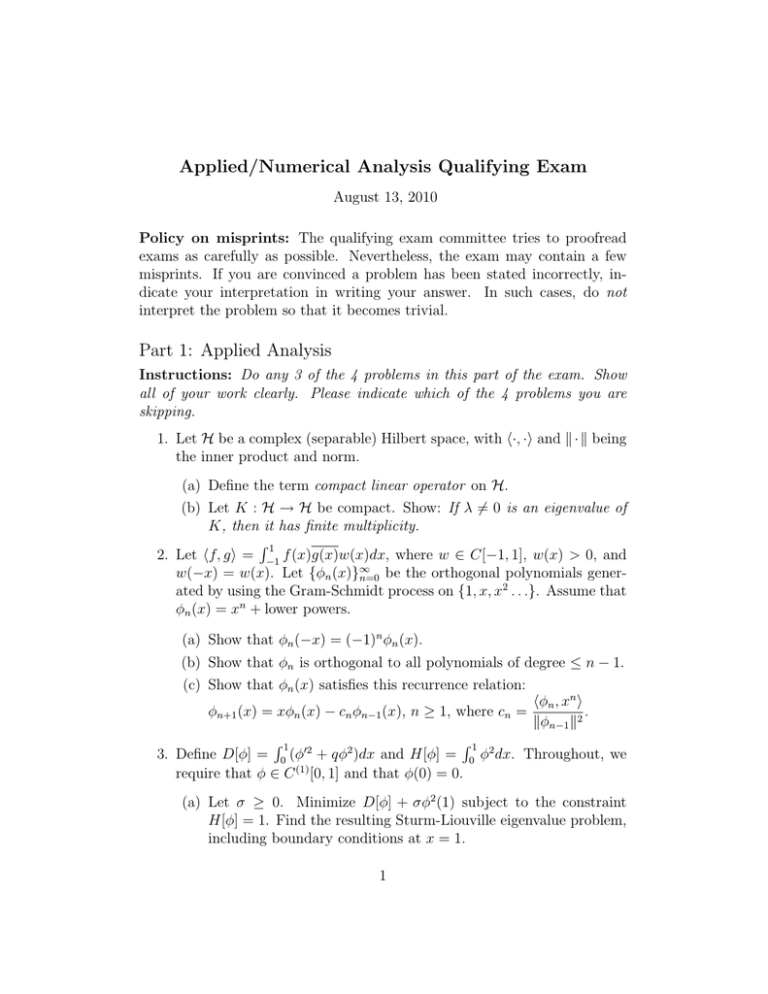
Applied/Numerical Analysis Qualifying Exam
August 13, 2010
Policy on misprints: The qualifying exam committee tries to proofread
exams as carefully as possible. Nevertheless, the exam may contain a few
misprints. If you are convinced a problem has been stated incorrectly, indicate your interpretation in writing your answer. In such cases, do not
interpret the problem so that it becomes trivial.
Part 1: Applied Analysis
Instructions: Do any 3 of the 4 problems in this part of the exam. Show
all of your work clearly. Please indicate which of the 4 problems you are
skipping.
1. Let H be a complex (separable) Hilbert space, with h·, ·i and k · k being
the inner product and norm.
(a) Define the term compact linear operator on H.
(b) Let K : H → H be compact. Show: If λ 6= 0 is an eigenvalue of
K, then it has finite multiplicity.
R1
2. Let hf, gi = −1 f (x)g(x)w(x)dx, where w ∈ C[−1, 1], w(x) > 0, and
w(−x) = w(x). Let {φn (x)}∞
n=0 be the orthogonal polynomials generated by using the Gram-Schmidt process on {1, x, x2 . . .}. Assume that
φn (x) = xn + lower powers.
(a) Show that φn (−x) = (−1)n φn (x).
(b) Show that φn is orthogonal to all polynomials of degree ≤ n − 1.
(c) Show that φn (x) satisfies this recurrence relation:
φn+1 (x) = xφn (x) − cn φn−1 (x), n ≥ 1, where cn =
hφn , xn i
.
kφn−1 k2
R1
R1
3. Define D[φ] = 0 (φ′2 + qφ2 )dx and H[φ] = 0 φ2 dx. Throughout, we
require that φ ∈ C (1) [0, 1] and that φ(0) = 0.
(a) Let σ ≥ 0. Minimize D[φ] + σφ2 (1) subject to the constraint
H[φ] = 1. Find the resulting Sturm-Liouville eigenvalue problem,
including boundary conditions at x = 1.
1
(b) State the Courant Minimax Principle. Consider Dirichlet boundary conditons φ(0) = 0, φ(1) = 0. Order the first and second
second eigenvalues for the two problems; that is if a, b, c, d are the
four eigenvalues, then determine their aorder, a ≤ b ≤ c ≤ d.
Justify your answer.
4. Let S be Schwartz space and S ′ be the space of tempered
R distributions.
ˆ
The Fourier transform convention used here is f (ω) = R f (t)eiωt dt.
(a) Define convergence in S. Sketch a proof: The Fourier transform
F is a continuous linear operator mapping S into itself. Briefly
explain how to use this to define the Fourier transform of a tempered distribution. This fails for D′ . Why?
(k) = (−iω)k T
b, where k =
(b) You are given that if T ∈ S ′ , then Td
1, 2, . . . . Let T (x) = 0 if x ∈
/ (0, 3). On [0, 3], let T be the linear
spline shown. Find Tb. (Hint: What is T ′′ ?)
1.5
(1,1)
(2,1)
1
y
0.5
y=T(x)
0
(0,0)
(3,0)
−0.5
0
0.5
1
1.5
x
2
2
2.5
3
Part 2: Numerical Analysis
Instructions: Do all problems in this part of the exam. Show all of your
work clearly.
1. Consider the system
−∆u − φ = f
u − ∆φ = g
(1)
in the bounded, smooth domain Ω, with boundary conditions u = φ = 0
on ∂Ω.
(a) Derive a weak formulation of the system (1), using¡ suitable test¢
functions for each equation. Define a bilinear form a (u, φ), (v, ψ)
such that this weak formulation amounts to
¡
¢
a (u, φ), (v, ψ) = (f, v) + (g, ψ).
(2)
(b) Choose appropriate function spaces for u and φ in (2).
(c) Show, that the weak formulation (2) has a unique solution. Hint:
Lax-Milgram.
(d) For a domain Ωd = (−d, d)2 , show that
kuk2 ≤ cd2 k∇uk2
(3)
holds for any function u ∈ H01 (Ωd ).
(e) Now change the second “-” in the first equation of (1) to a “+”.
Use (3) to show stability for the modified equation on Ωd , provided
that d is sufficiently small.
e1 , Σ), where τ =
2. Consider the two finite elements (τ, Q1 , Σ) and (τ, Q
2
[−1, 1] is the reference square and
©
ª
Q1 = span 1, x, y, xy ,
©
ª
e1 = span 1, x, y, x2 − y 2 .
Q
Σ = {w(−1, 0), w(1, 0), w(0, −1), w(0, 1)} is the set of the values of a
function w(x, y) at the midpoints of the edges of τ .
3
(a) Which of the two elements is unisolvent? Prove it!
(b) Show that the unisolvent element leads to a finite element space,
which is not H 1 -conforming.
3. Consider the following initial boundary value problem: find u(x, t) such
that
ut − uxx + u = 0,
0 < x < 1, t > 0
ux (0, t) = ux (1, t) = 0,
u(x, 0) = g(x),
t>0
0 < x < 1.
(a) Derive the semi-discrete approximation of this problem using linear finite elements over a uniform partition of (0, 1). Write it as a
system of linear ordinary differential equations for the coefficient
vector.
(b) Further, derive discretizations in time using backward Euler and
Crank-Nicolson methods, respectively.
(c) Show that both fully discrete schemes are unconditionally stable
with respect to the initial data in the spatial L2 (0, 1)-norm.
4

